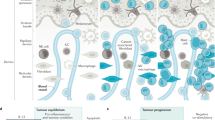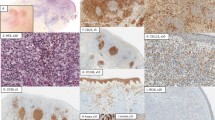Abstract
The objectives of this study were to evaluate the outcome after polychemotherapy for patients with primary cutaneous large-cell lymphomas (PCLL) and to validate the recently proposed immunohistologic classification of cutaneous lymphomas. Among 140 patients with positive skin biopsies included in the LNH87 protocol (for treatment of aggressive lymphomas), 49 patients met the criteria of PCLL. Characteristics were: sex ratio M/F, 2.3; age 18 to 83 years (median, 52), peripheral lymph nodes, n = 22; diffuse disease, n = 12; median tumor size, 4.5 cm; elevated lactate dehydrogenase, n = 9; ECOG: 0/1, n = 49. Histology was: follicular center B cell, n = 23; B-lymphoblastic, n = 1; anaplastic large-cell lymphoma, n = 14 (T cell phenotype n = 8); CD30− T cell lymphoma, n = 11. All patients received polychemotherapy: under 70 years, ACVBP (three to four cycles and consolidation for 6 months) n = 25; mBACOD (eight cycles) n = 16; over 70 years, C(T)VP (six cycles) n = 8. Radiation therapy was not included in the protocol. With a median follow-up of 5 years, 24/49 patients had relapsed, with 20 skin relapses. Event-free (EFS) and overall survival (OS) at 5 years were, respectively, 50 and 77%. Significant adverse prognostic factors were: histology (CD30− T cell lymphoma) and diffuse cutaneous disease (>10% of skin). The presence of nodal involvement was only significant for EFS. When compared to 140 non-cutaneous lymphoma patients included in the same trial and fully matched for the main clinical characteristics, OS was similar. In conclusion, PCLL behaves like other localized B or T cell extranodal lymphomas with the same prognostic factors (LDH, ECOG, age) except for CD30+ PCLL which have a very good prognosis.
This is a preview of subscription content, access via your institution
Access options
Subscribe to this journal
Receive 12 print issues and online access
$259.00 per year
only $21.58 per issue
Buy this article
- Purchase on Springer Link
- Instant access to full article PDF
Prices may be subject to local taxes which are calculated during checkout
Similar content being viewed by others
Author information
Authors and Affiliations
Consortia
Rights and permissions
About this article
Cite this article
Brice, P., Cazals, D., Mounier, N. et al. Primary cutaneous large-cell lymphoma: analysis of 49 patients included in the LNH87 prospective trial of polychemotherapy for high-grade lymphomas. Leukemia 12, 213–219 (1998). https://doi.org/10.1038/sj.leu.2400911
Received:
Accepted:
Published:
Issue Date:
DOI: https://doi.org/10.1038/sj.leu.2400911
Keywords
This article is cited by
-
Remission of primary cutaneous anaplastic large cell lymphoma after a brief course of brentuximab vedotin
Annals of Hematology (2013)
-
Primary cutaneous anaplastic large cell lymphoma of the vulva: a typical cutaneous lesion with an ‘atypical’ presenting site
International Journal of Hematology (2009)
-
High-dose therapy and autologous stem cell transplantation in relapsing cutaneous lymphoma
Bone Marrow Transplantation (2004)
-
Effective high-dose chemotherapy combined with CD34+-selected autologous peripheral blood stem cell transplantation in a patient with cutaneous CD30-negative large T cell lymphoma
Bone Marrow Transplantation (2000)



